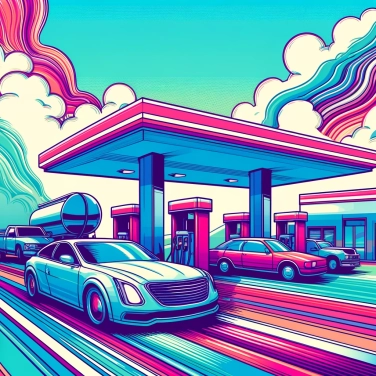Most cars run on gasoline because this fuel is easy to produce, store and distribute, and offers a good energy density for satisfactory range.

Gasoline often remains cheaper at the pump than other fuels that are still relatively rare, such as hydrogen or certain bio alternatives. This attractive price mainly stems from massive production and industrial processes optimized over decades, allowing reduced costs for suppliers and ultimately for consumers. The result: filling up the tank with gasoline generally weighs less on the wallet. Even when prices fluctuate, gasoline often maintains a certain competitiveness due to sometimes more favorable taxes compared to diesel, LPG, or alternative fuels. For someone closely monitoring their daily expenses, this economic factor often remains decisive in the vehicle purchase.
The network of gas stations is ultra developed and accessible almost everywhere. You drive a few kilometers, and there’s a gas station. Even in the countryside or on remote roads, it’s impossible to run completely dry for long. It’s definitely reassuring to have this ease of refueling, especially for long journeys. In contrast, finding electric charging points or hydrogen stations is still much more difficult outside major cities. This extensive coverage naturally makes gas much more practical for most people in their daily lives.
gasoline engines generally offer quick acceleration and good responsiveness, which are appreciated advantages for overtaking or climbing. In terms of range, these engines have a clear advantage: with a full tank, one can often easily cover 500 to 700 kilometers, or even more depending on the models, without worrying about the next refill. It is this practical balance between satisfactory performance and comfortable range that convinces many drivers to prefer gasoline for their daily commutes as well as for long trips. Even though other technologies are advancing, gasoline remains a reliable choice today when driving far, for long periods, or with a good dose of pleasure behind the wheel.
At the beginning, at the end of the 19th century, the first gasoline internal combustion engines quickly established themselves over other solutions, particularly electric or steam models, because they were lighter, more practical, and offered superior range. Throughout the 20th century, automobile manufacturers heavily invested in gasoline technology, leading to significant advancements such as direct injection, improved ignition systems, and optimized combustion. These regular advances and strong industrial support enabled gasoline cars to become reliable, easy to produce on a large scale, financially accessible, and firmly rooted in the collective imagination as the automotive standard.
The majority of drivers prefer gasoline vehicles because it has become a deeply ingrained habit. For decades, this has been the most common type of engine, so people naturally gravitate towards what they know well. They appreciate its simplicity: you fill up in a few minutes at the pump and drive away without any hassle. Many also associate gasoline with a certain peace of mind, because cars are easy to repair, garages know these engines inside out, and you never struggle for long to find your replacement part. Clearly, the practicality and familiar reassurance of gasoline make it an automatic choice for a lot of people.
The modern gas station as we know it today first appeared in the United States, in Pittsburgh, in 1913, revolutionizing the accessibility and use of gasoline-powered vehicles.
The first practical gasoline engine developed by Karl Benz dates back to 1885 and initially had only 0.75 horsepower, a far cry from today’s engines that easily exceed 100 horsepower.
Although gasoline still predominates overall, some countries are considering gradually banning the sale of new gasoline cars to promote electric vehicles and reduce harmful emissions.
The traditional gasoline engine produces a controlled explosion of gasoline vapors, which allows for the conversion of chemical energy into mechanical energy, thus propelling your vehicle forward.
Yes, some simple actions can help reduce consumption, such as smoother driving (avoiding sudden accelerations or braking), maintaining a steady speed, regularly servicing your vehicle, and frequently checking tire pressure to ensure optimal efficiency.
Although the automotive market is evolving with the rapid development of electric and hybrid vehicles, gasoline cars will still be very prevalent for several more years. This transition will take time and will depend in particular on investments in infrastructure and public policies favoring clean energy.
The main disadvantages include their higher environmental footprint due to polluting emissions and greenhouse gases, as well as their dependence on fluctuating oil prices and limited long-term fossil resources.
Not necessarily in terms of torque and initial acceleration, as electric motors provide high instant torque. However, gasoline vehicles generally offer better range on long trips and significantly faster refueling, which makes them more suitable for certain usage conditions.
Gasoline cars remain dominant due to a more accessible initial cost, a widely spread refueling network, an extended driving range, and consumer usage habits that have been well established for decades.

No one has answered this quiz yet, be the first!' :-)
Question 1/5